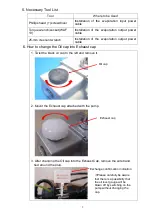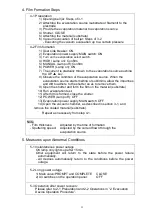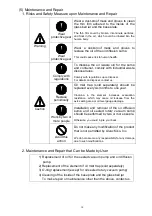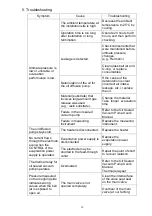
18
5. Troubleshooting
Symptom
Cause
Troubleshooting
Ultimate pressure is
low or unstable, or
evacuation
performance is low.
The ambient temperature at
the installation site is high.
Decrease the ambient
temperature to 25°C by
cooling.
Operation time is too long
after installation or long
termination.
Operate 24 hours to 48
hours, and then perform
checking.
Leakage is detected.
Check components that
were maintained before
ultimate pressure
changes.
(e.g., Hermetic)
Clean glass bell jar and
O-ring, or replace
consumables.
Deterioration of the oil for
the oil diffusion pump.
If the cause of the
deterioration is clear
(incorrect air intake,
leakage, etc.), replace
the oil.
Material (substrate) that
involves large-amount gas
release was used
(e.g., resin substrate).
Change the material.
Take longer evacuation
time.
Failure in the oil sealed
vacuum pump
Refer to the Oil Sealed
Vacuum Pump User’s
Manual.
Failure in measuring
instrument
Replace the measuring
instrument.
The oil diffusion
pump stays cold.
The heater is disconnected.
Replace the heater.
No current flows
through the electrode
even when the
CONTROL of the
evaporation power
supply is operated.
Evaporation power supply is
disconnected.
Replace the
evaporation power
supply.
The electrode may be
shorted in the feed-through
collar.
Repair the point of short
to recover isolation.
The thermal relay for
oil sealed vacuum
pump operates.
Overloaded
Refer to the Oil Sealed
Vacuum Pump User’s
Manual.
Thermal relay set
Pressure measured
on the roughing side
indicates wrong
values when the bell
jar is exposed to
open air.
The main valve is not
opened completely.
Clean the internal face
of the valve seat seal
on the main valve.
Overhaul of the main
valve (at our factory)




































